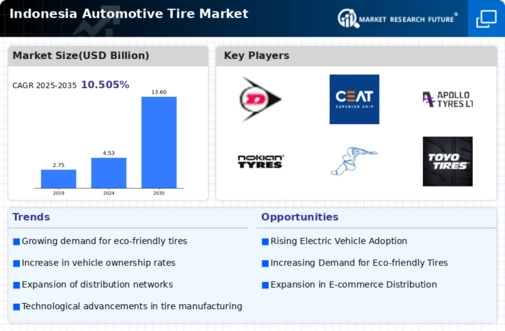Rising Fuel Prices
Rising fuel prices in Indonesia are influencing consumer behavior and, consequently, the automotive tire market. As fuel costs increase, vehicle owners may seek to optimize their fuel efficiency, leading to a greater demand for tires that enhance mileage. In 2025, fuel prices are expected to rise by 15%, prompting consumers to invest in high-quality tires that offer better performance and lower rolling resistance. This trend suggests that consumers are becoming more discerning in their tire choices, prioritizing products that contribute to cost savings in fuel consumption. The automotive tire market is likely to respond by offering a wider range of fuel-efficient tire options, catering to the needs of cost-conscious consumers.
Rising Vehicle Ownership
The market is experiencing growth due to the increasing rate of vehicle ownership. As more individuals acquire personal vehicles, the demand for tires rises correspondingly. In 2025, vehicle ownership in Indonesia is projected to reach approximately 20 million units, leading to a heightened need for replacement tires. This trend is further supported by the expanding middle class, which is likely to prioritize personal transportation. Consequently, the automotive tire market is expected to benefit from this surge in vehicle numbers, as consumers seek quality tires for safety and performance. The growth in vehicle ownership not only stimulates demand for tires but also encourages manufacturers to innovate and diversify their product offerings to cater to a broader consumer base.
Infrastructure Development
Infrastructure development in Indonesia plays a crucial role in shaping the automotive tire market. The government's commitment to enhancing road networks and transportation facilities is likely to facilitate smoother travel and increase vehicle usage. With ongoing projects aimed at improving highways and urban roads, the demand for durable and high-performance tires is expected to rise. In 2025, the government allocates approximately $10 billion for infrastructure projects, which could lead to a significant uptick in vehicle movement. As road conditions improve, consumers may opt for tires that offer better grip and longevity, thereby influencing purchasing decisions. This trend indicates a direct correlation between infrastructure advancements and the growth of the automotive tire market.
Shift Towards Electric Vehicles
The automotive tire market in Indonesia is witnessing a shift towards electric vehicles (EVs). This shift is likely to impact tire demand. As the government promotes EV adoption through incentives and subsidies, the market for tires specifically designed for electric vehicles is expected to expand. In 2025, the number of electric vehicles on Indonesian roads is projected to increase by 30%, creating a niche market for specialized tires that cater to the unique requirements of EVs. These tires often feature lower rolling resistance and enhanced durability, appealing to environmentally conscious consumers. This transition towards electric mobility not only diversifies the automotive tire market but also encourages manufacturers to innovate in tire technology, aligning with the evolving automotive landscape.
Increased Focus on Safety Standards
The automotive tire market in Indonesia is experiencing a heightened focus on safety standards. This focus is driven by consumer awareness and regulatory changes. As road safety becomes a priority, consumers are more inclined to invest in tires that meet stringent safety criteria. In 2025, it is anticipated that regulatory bodies will implement new safety standards for tires, which could lead to a shift in purchasing behavior. Consumers may prioritize brands that demonstrate compliance with these standards, thereby influencing market dynamics. This increased emphasis on safety is likely to encourage manufacturers to enhance their product offerings, ensuring that they meet or exceed safety expectations. Consequently, the automotive tire market may witness a transformation as safety becomes a key differentiator in consumer decision-making.























Leave a Comment